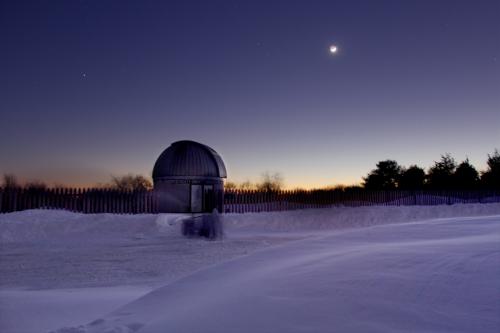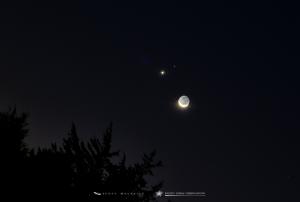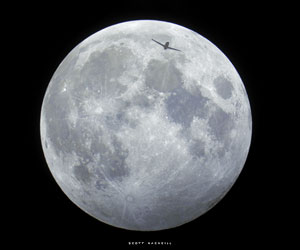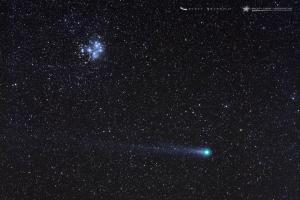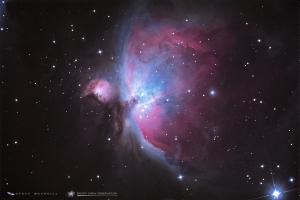Starry Nights of February
Winter can be a challenge to amateur astronomers in southern New England. The weather can be very snowy, or the temperatures can be so low that even I need some special incentive to venture outdoors to observe. However, if Mother Nature can provide us with a happy medium between these two scenarios, there are several astronomical highlights you should try to explore during February.
You’ve no doubt noticed that bright beacon Venus in the southwestern sky after sunset. Have you also noticed a reddish star-like object to Venus’ upper left? That’s not a star. It’s the planet Mars. In one quick glance you can observe our two neighbors. And on January 31 a waxing crescent Moon joins this planetary pairing to form a beautiful triangle. Capture this sky scene with a camera and share your experience with family and friends.
Venus goes through phases similar to that of the Moon, so if you have a telescope you can observe Venus as she starts the month out in a waxing crescent phase and at a distance of about 49,600,000 miles. Watch as the illuminated phase decreases throughout the month. Venus will also increase in apparent size as the planet moves closer to the Earth, being about 33,000,000 miles away by month’s end.
And while you could also focus in on Mars with a telescope, little if no detail would be discernible since on February 1 this desert world will be just over 172,500,000 miles away. By the 28th that distance will have increased to a little more than 189,000,000 miles. I would suggest waiting until a few months before or after July 31, 2018, when Mars will be next closest to the Earth at around 35,800,000 miles. You’ll observe much surface detail during this time of close approach.
On February 10 we will be well positioned to observe a lunar eclipse. Unfortunately this event will only be a penumbral eclipse with the Moon sliding through the Earth’s lighter shadow. With no media coverage I doubt whether anyone would notice the phenomenon at all.
However, if you follow the progression of the eclipse you should notice that the top portion of the Moon will look dusky because it will be deep within the penumbral shadow, just missing the dark umbral shadow. The eclipse begins at 5:34 p.m., with maximum eclipse at 7:44 p.m. The eclipse ends at 9:53 p.m. All times are EST (Eastern Standard Time). Check out this and this animation.
In addition, on February 25, 26 and 27, a telescope with a low power eyepiece will reveal Uranus, seventh planet from the Sun, located about one Full Moon diameter away from Mars in the western sky after sunset. Uranus’ planetary disk will look like a tiny blue-green marble. The contrast with reddish Mars will be quite distinct.
The winter sky contains the brightest stars we can see from the Earth. And two of my favorite objects to observe can be found among them. First up is the Pleiades open star cluster. It’s easy to identify with the naked-eye in the constellation Taurus. It is also known as the Seven Sisters in Greek mythology. And some of you may recognize it as the logo for the car brand Subaru. Casual stargazers often think it is the “little dipper” (Ursa Minor).
The Pleiades stars formed about one hundred million years ago from a common dust cloud, most likely similar in appearance to the Orion Nebula today. The cluster is about 440 light years away. Long photographic exposures show some dust surrounding the cluster, originally thought to be remnants of the original stellar nursery from which it formed. However, it is now believed to be a dust cloud through which the Pleiades stars are passing.
In a really dark sky with a large telescope an observer can glimpse this nebulosity. While binoculars do show a nice image, the ideal sight you want to achieve is with a telescope under low magnification so the entire cluster fits into the field of view. The Pleiades remind me of sparkling diamonds scattered upon black velvet.
My second favorite object resides in the neighboring constellation of Orion. Locate the three stars that represent his belt. Beneath the belt is a curved stream of stars that can be seen in a dark sky. This group of stars represents Orion’s sword. A pair of binoculars will reveal a fuzzy patch of light where the middle “star” is located. Any low magnification telescope will reveal its true nature—the Orion Nebula—another vast star-forming region in our Milky Way Galaxy.
With the eye one can see vast green-tinted wispy tendrils of the nebula that stretch out from the center, which is about 1,350 light years away and some 30 light years across. Long-duration images show the nebula to be pink and blue. In the future many more stars will be born here. In fact, research shows there are approximately 700 stars embedded within the dust cloud, ready to emerge. For now there are four primary stars only one million years-old, called the Trapezium, in the central region of the nebula. One day this region will be ablaze with new stars.
The Pleiades and the Orion Nebula are incredibly beautiful stellar birth places that can lure me out into a crystal clear and cold winter night.
So don’t hibernate like a bear. When Ursa Major and Ursa Minor put in an appearance in the northern sky, you can then step outside of your cozy den to observe the many interesting astronomical objects awaiting your attention. And be sure to visit the local observatories for some great views of the heavens.
Seagrave Memorial Observatory in North Scituate is open to the public every clear Saturday night. Ladd Observatory in Providence is open every clear Tuesday night. The Margaret M. Jacoby Observatory at the CCRI Knight Campus in Warwick is open every clear Wednesday night. Frosty Drew Observatory in Charlestown is open every clear Friday night year-round.
Great American Total Solar Eclipse on August 21, 2017. Countdown: 200 days as of February 1, 2017.
Keep your eyes to the skies.
David A. Huestis
- Author:
- David Huestis
- Entry Date:
- Feb 13, 2017
- Published Under:
- David Huestis's Columns

